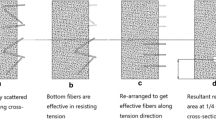Abstract
At present, mostly the application of steel fibre reinforced concrete (SFRC) is limited to non-structural concrete such as slope stabilization, tunnel linings, roads and pavements, hard standings and floorings, bridges and overlays which can be attributed to the lack of relevant guidelines in current design concrete codes. As a conspicuous mark towards promising the use of SFRC as structural concrete, a provision includes in ACI 318-08 and reestablished in ACI 318-19, in which the minimum shear reinforcement of a beam can be replaced by deformed steel fibres. ACI 318-08 also provides the flexural performance norms (FPN) supported by the ASTM C1609-12 4-point bend test for the replacement of minimum shear reinforcement through steel fibres. In the current study, experimental investigation on the basis of ASTM C1609 4-point bend test on SFRC prisms were carried out and presented. The deformed steel fibres were used in the concrete matrix at volume fractions ranging from 0.5 to 1.5%. Moreover, the flexural performance in terms of load vs deflection graphs, load-bearing ability & toughness was accurately monitored. Further, the test analysis reveals that the “post cracking behaviour” of SFRC beams is enhanced due to the incorporation of “fibres in the concrete matrix”. Further, it is concluded that from the workability and flexural performance point of view, the hooked-end type of fibres works effectively.











Similar content being viewed by others
Availability of data and material
Not applicable.
Code availability
Not applicable.
Abbreviations
- b :
-
Beam width, mm
- D :
-
Diameter of the cylinder specimen, mm
- h :
-
Overall depth of the beam, mm
- l :
-
Length of the cylinder specimen, mm
- L :
-
Beam span length, mm
- P :
-
Failure load, N
- f t :
-
Split tensile strength of concrete, MPa
- f LOP :
-
Strength at the limit of proportionality (f1), N/mm2
- f MOR :
-
Strength at modulus of rupture (fr), N/mm2
- f 300 :
-
Completive strength at L/300, N/mm2
- f 150 :
-
Completive strength at L/150, N/mm2
- P LOP :
-
Load at the limit of proportionality, kN
- P MOR :
-
Load at modulus of rupture, kN
- ToughLOP :
-
Toughness at the limit of proportionality, N-m
- ToughMOR :
-
Toughness at modulus of rupture, N-m
- V f :
-
Volume fraction of fibre, %
- δ LOP :
-
Deflection at the limit of proportionality, mm
- δ MOR :
-
Deflection at modulus of rupture, mm
- L/600:
-
Resultant deflection of span/600, mm
- L/300:
-
Resultant deflection of span/300, mm
- L/150:
-
Resultant deflection of span/150, mm
References
ACI 544.4R. (2018). Guide to design with fiber-reinforced concrete. American Concrete Institute.
ACI Committee 318–08. (2008). Building Code Requirements for Structural Concrete (ACI 318–08) and Commentary (p. 74). Farmington Hills: American Concrete Institute.
ACI Committee 544. (2008). Guide for specifying, proportioning, and production of fiber-reinforced concrete, ACI 544.3R-08. American Concrete Institute.
ACI Committee 318. (2019). Building code requirements for structural concrete (ACI 318-19) and commentary (ACI 318R-19) (p. 623). American Concrete Institute.
Algassem, O., Li, Y., & Aoude, H. (2019). Ability of steel fibers to enhance the shear and flexural behavior of high-strength concrete beams subjected to blast loads. Engineering Structures, 199, 611.
Altun, F., Haktanir, T., & Ari, K. (2007). Effect of steel fibre on mechanical properties of concrete and RC beams. Construction and Building Materials, 21, 654–661.
ASTM A370-18. (2018). Standard test methods and definitions for mechanical testing of steel products. ASTM International, West Conshohocken, PA.
ASTM C 1018-97. (1998). Standard test method for flexural toughness and first-crack strength of fibre reinforced concrete (Using Beam With Third-Point Loading) (pp. 544–551). American Society of Testing and Materials.
ASTM C1609-12. (2012). Standard test method for flexural performance of fiber-reinforced concrete (using beam with third-point loading). ASTM International.
ASTM C78 / C78M-18. (2018) Standard test method for flexural strength of concrete (Using Simple Beam with Third-Point Loading). ASTM International, West Conshohocken, PA.
ASTM C 496-17. (2018). Standard test method for splitting tensile strength of cylindrical concrete specimens. ASTM International.
ASTM C31-19. (2019). Standard practice for making and curing concrete test specimens in the field. ASTM International.
Banthia, N., & Trottier, J.-F. (1995). Concrete reinforced with deformed steel fibres, Part II: Toughness characterization. ACI Materials Journal, 92(2), 146–154.
Bhutta, A., Farooq, M., & Banthia, N. (2019). Performance characteristics of micro fiber-reinforced geopolymer mortars for repair. Construction and Building Materials, 215, 605–612.
Erdogmus, E. (2015). Use of fibre-reinforced cements in masonry construction and structural rehabilitation. Fibers, 3(1), 41–63.
Gao, J., Sun, W., & Morino, K. (1997). Mechanical properties of steel fiber-reinforced, high-strength, lightweight concrete. Cement and Concrete Composites, 19(4), 307–313.
Gopalaratnam, V. S., & Gettu, R. (1995). On the characterization of flexural toughness in fibre reinforced concretes. Cement Concrete Composites, 17, 239–254.
Jain, K., & Negi, B. S. (2020). Assessment of codal provision for SFRC beam in minimum Shear. In: RILEM-fib International Symposium on Fibre Reinforced Concrete (pp. 791–800). Springer, Cham.
Jain, K., & Singh, B. (2013). Steel fibres as minimum shear reinforcement in reinforced concrete beams. Magazine of Concrete Research, 65(7), 430–440.
Jang, S. J., & Yun, H. D. (2018). Combined effects of steel fiber and coarse aggregate size on the compressive and flexural toughness of high-strength concrete. Composite Structures, 185, 203–211.
Karimipour, A., & Ghalehnovi, M. (2021). Comparison of the effect of the steel and polypropylene fibres on the flexural behaviour of recycled aggregate concrete beams. In: Structures (Vol. 29, pp. 129–146). Elsevier.
Kim, D. J., El-Tawil, S., & Naaman, A. E. (2008). Comparative flexural behaviour of four fibre reinforced cementations composites. Cement Concrete Composites, 30(10), 917–928.
Lee, S.-C., Oh, J.-H., & Cho, J.-Y. (2015). Compressive behavior of fiber-reinforced concrete with end-hooked steel fibers. Materials, 8, 1442.
Okeh, C. A., Begg, D. W., Barnett, S. J., & Nanos, N. (2019). Behaviour of hybrid steel fibre reinforced self compacting concrete using innovative hooked-end steel fibres under tensile stress. Construction and Building Materials, 202, 753–761.
Simões, T., Costa, H., Dias-da, C. D., & Júlio, E. (2017). Influence of fibres on the mechanical behaviour of fibre reinforced concrete matrixes. Construction and Building Materials, 137, 548–556.
Song, P. S., & Hwang, S. (2004). Mechanical properties of high-strength steel fibre reinforced concrete. Construction and Building Materials, 18(9), 669–673.
Soulioti, D. V., Barkoula, N. M., Paipetis, A., & Matikas, T. E. (2011). Effects of fibre geometry and volume fraction on the flexural behaviour of steel-fibre reinforced concrete. Strain, 47(SUPPL. 1), 535–541.
Soutsos, M. N., Le, T. T., & Lampropoulos, A. P. (2012). Flexural performance of fibre reinforced concrete made with steel and synthetic fibres. Construction and Building Materials, 36, 704–710.
Tadepalli, P. R., Mo, Y. L., & Hsu, T. T. C. (2013). Mechanical properties of steel fibre concrete. Magazine of Concrete Research, 65(8), 462–474.
Thomas, J., & Ramaswamy, A. (2007). Mechanical properties of steel fibre reinforced concrete. ASCE Journal of Materials in Civil Engineering, 19(5), 385–392.
Wafa, F. F., & Ashour, S. A. (1992). mechanical properties of high-strength fiber reinforced concrete. ACI Materials Journal, 89(5), 449–455.
Wang, X., Fan, F., Lai, J., & Xie, Y. (2021). Steel fiber reinforced concrete: A review of its material properties and usage in tunnel lining. In: Structures (Vol. 34, pp. 1080–1098). Elsevier.
Williamson, G. R. (1974). The effect of steel fibres on the compressive strength of concrete (pp. 195–207). Farmington Hills: American Concrete Institute. Fibre Reinforced Concrete SP-44.
YazıcıInan Tabak, S. G. V. (2007). Effect of aspect ratio and volume fraction of steel fiber on the mechanical properties of SFRC. Construction and Building Materials, 21, 1250–1253.
Acknowledgements
The authors gratefully acknowledge the helps of the personnel belonging to Concrete and Heavy Test Laboratory, Department of Civil Engineering, IIT Roorkee, for the experimental program.
Funding
Not applicable.
Author information
Authors and Affiliations
Contributions
K.J designed and experimented. B.S.N analyzed the data and prepare the final version of the manuscript under the supervision of K.J.
Corresponding author
Ethics declarations
Conflict of interest
The authors declare that there is no conflict of interest.
Ethical statement
The manuscript has been drafted by the inputs of both authors which is not published before, it has been only submitted to this journal, and if accepted, it will not be submitted anywhere else in any language.
Additional information
Publisher's Note
Springer Nature remains neutral with regard to jurisdictional claims in published maps and institutional affiliations.
Rights and permissions
About this article
Cite this article
Jain, K., Negi, B.S. Analysis of steel fibre reinforced concrete beams in flexure: the experimental investigation. Asian J Civ Eng 22, 1625–1637 (2021). https://doi.org/10.1007/s42107-021-00401-z
Received:
Accepted:
Published:
Issue Date:
DOI: https://doi.org/10.1007/s42107-021-00401-z




